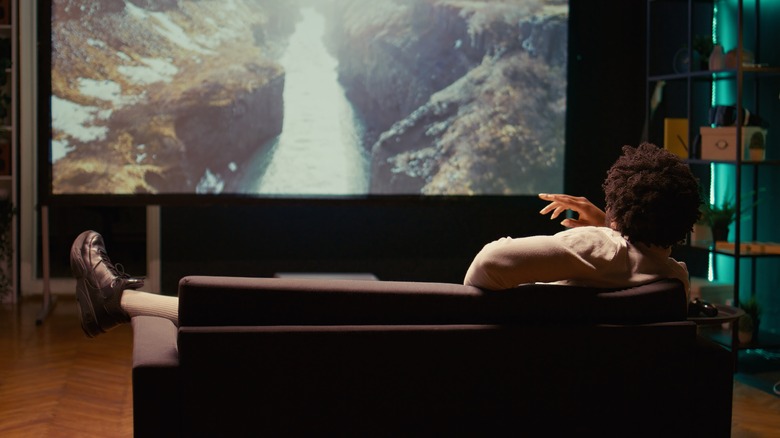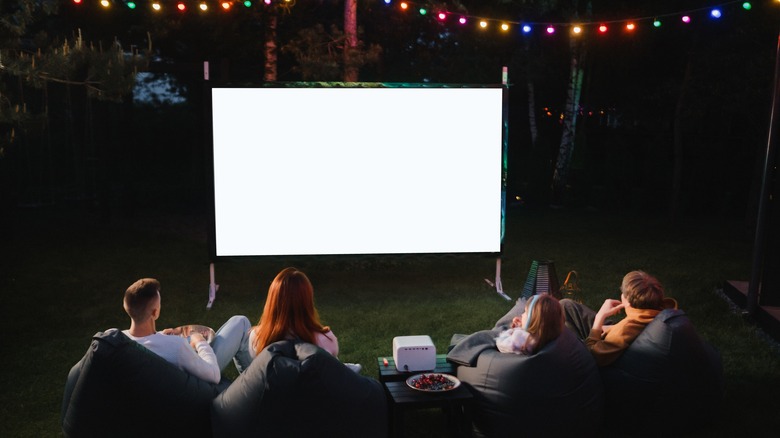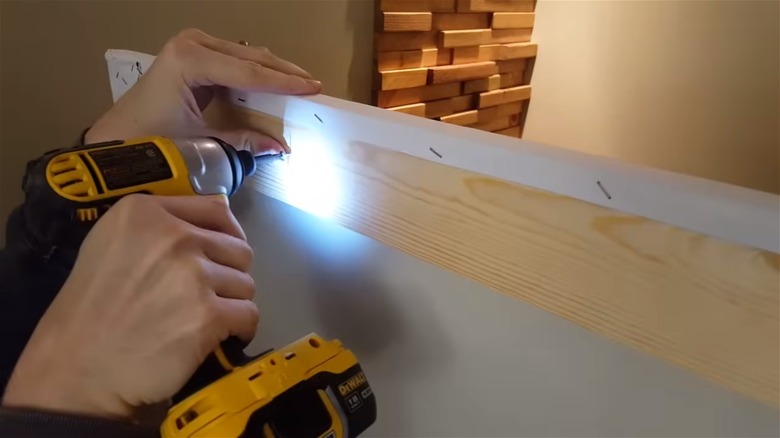Is It Really Cheaper To Build Your Own Projector Screen?
We may receive a commission on purchases made from links.
One of the best ways to recreate the movie theater experience at home is to incorporate a high-quality projector. According to VerifiedMarketResearch.com, the projector market is expected to grow to $21.74 billion in the next seven years. We covered the best new projector we've seen recently with our best of CES 2024 coverage. However, without a dedicated screen to properly display your entertainment, you'll have less than desirable results. Depending on the type of screen, size, and material used, some retail options can run well over $200. This prompts many new projector owners to turn to popular platforms like YouTube, which offer several instructional, do-it-yourself screen options. These how-to videos claim to save you significant amounts of money over purchasing a premade product, but do they?
While both ready-made and homemade projector screens can vary widely in quality, there are some vital considerations that will determine the cost between the two. First, to build your own screen, you'll need power tools that can dramatically increase the cost of the project if you don't already own them. Secondly, there is more to a screen than just white fabric. In fact, there are specialized materials that perform differently based on light conditions, viewing angles, and gain (how much light the screen reflects back). Therefore, would it be cheaper to tack up a white bedsheet to your wall rather than pay for a premium projector screen? Yes, but the results wouldn't be comparable in terms of image quality.
The hidden costs of do-it-yourself projects
Online video platforms have been a real asset in helping guide viewers in completing simple home projects and repairs without the need for costly professional services. However, the titles of these how-to videos can sometimes be misleading, claiming a home project will remain well under the cost of buying a premade product. For example, one video claimed you could make a projector screen for under $30 and showed a step-by-step project where the creator uses a table router, miter-saw, band-saw, power drill, staple gun, and pocket screw jig.
A quick glance at any major hardware store reveals that you'll spend significantly more than $30 on this project if you need to purchase the tools. For example, expect at minimum to pay around $180 for a router with table, $154 for a miter saw, $150 for a band saw, $30 for a cordless power drill, $14 for a staple gun, and $20 for a pocket screw jig. Before the cost of any materials, the do-it-yourself projector screen will cost you about $550 if you don't happen to already own these tools.
Also, bear in mind an instructional video that includes material costs may be several years old and not reflect current prices for wood, fasteners, and paint. If you happen to already own most of these tools, have some spare wood lying around, and enjoy building things, a homemade projector screen project might be relatively inexpensive.
Projector screen fabric types
Choosing the right screen material is crucial to keep your projector's image looking bright and sharp. The amount of light in your entertainment space should influence the level of gain or screen reflection present. If you have a windowless theater room, for instance, a matte white material will offer you a superior picture. However, the matte white fabric will struggle to produce quality images in a bright room, and you should opt instead for a matte silver or gray fabric, which can still produce dark images by reflecting less ambient light.
You might also consider a fabric with anti-glare technology designed to help evenly distribute the light from the projector across the screen. A white bed sheet (which offers no anti-glare features), for example, will exhibit a very noticeable oval of brighter light in the center, creating what looks similar to a spotlight. Anti-glare fabric, on the other hand, diffuses the light from the projector, providing a uniform appearance.
Ready-made vs do-it-yourself pricing
Buying a premade projector screen can range in price from only around $7 upwards to over $16,000. The price depends significantly on the material used, the size of the screen, features like electric vs pull-down screens, and fixed frame vs foldable. If you plan to view standard definition content and aren't picky about image quality, you can opt for the less expensive 100-inch, anti-crease, 16:9 screens that can be installed with hooks or tacked up to a wall for less than $30. However, if you plan to project higher resolutions and desire better image quality, you can expect to pay at least a few hundred dollars for ready-made premium screens around 100 inches.
If you do decide to construct your own projector screen, consider purchasing specialty projector fabric that factors in your viewing environment. There are projector fabric rolls available for less than $200 capable of producing higher quality viewing at 100 inches and above screen sizes. Look for details such as gain figures and anti-glare or light-diffusing properties for a better overall viewing experience. Ultimately, the homemade cost will greatly depend on what tools you already own and the quality of materials you use. Before you begin, you may want to read up on the various tips and tricks for getting started on your DIY home theater project, as there are several components to consider.



